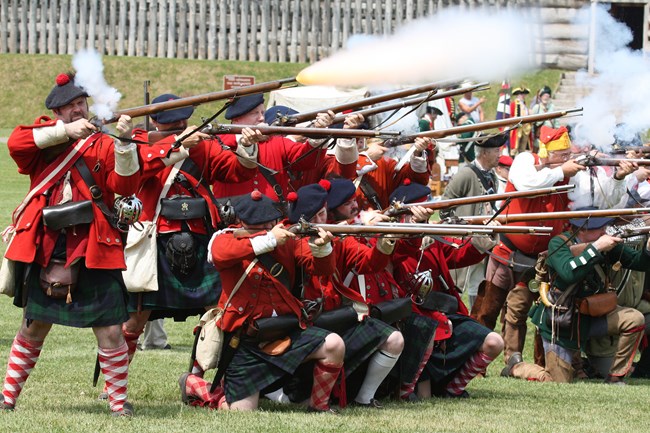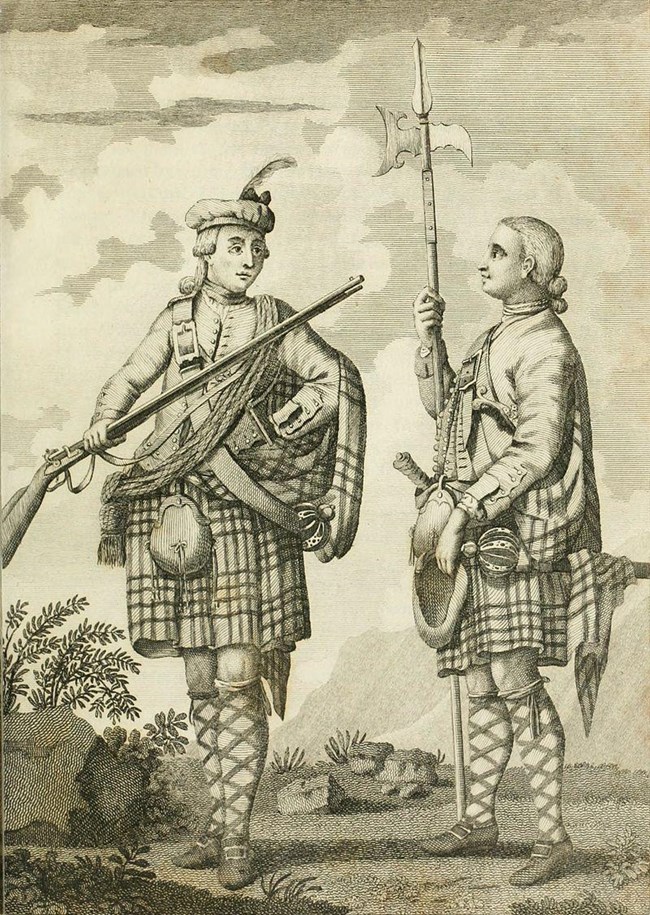Last updated: October 8, 2022
Article
Scottish Highland Regiments in the Mohawk Valley 1758-1760

NPS/M. Hutchko
Lieutenant Colonel Fraser’s regiment landed in Canada in late August of 1757 and spent the winter in Connecticut. In June of 1758, the 78th Highlanders became part of the British army under General Jeffery Amherst that attacked the French fortified town of Louisbourg. The troops landed in large flat-bottomed boats under heavy French fire and Sergeant James Thompson of the regiment remembered “One 24 pound shot did a great deal of mischief. It passed under my hams and killed Sergent McKenzie,…and it carried away the basket of his broadsword which, along with the shot, passed through Lieutenant Cuthbert,…tore his body into shivers and cut off both legs of one of the two fellows that held the tiller of the boat…Although this shot did not touch me, the thighs and calves of my legs were affected and became as black as my hat, and for several weeks I suffered a great deal of pain.” Thompson also recounts that the only reason their boat didn’t sink is because the men were stuffing their plaids (the extra cloth of the kilt) in all of the holes in the boat. Despite this bloody start, the British successfully besieged the town and on July 27, Louisbourg surrendered to the British. The 78th had been part of General James Wolf brigade during the siege, and their service seems to have changed his mind about the true usefulness of highland soldiers. Sgt. Thompson recorded that “…while before Louisbourg…the Camp where our Regiment lay, was three miles distant from the General’s, yet he almost everyday came to see Us, when our men would “turn-out” to him with the greatest alacrity…” The Fraser’s dubbed Wolf “the red-haired Corporal” due to his hair color and his preferred general’s insignia looking like a corporal’s epaulette.

National Park Service
One of the garrison’s biggest winter enemies was the snow that could potentially block up the fortifications and fill up the yet unfinished ditch. On December 5th, Major Clephane ordered: “When the men are ordered to Clear the Bastions [corners] and the curtains [walls] of Snow they are to make it up in great Balls and Therewith fill up the Hollows without the Gate near the Fort…” and on December 26th, he ordered “All the Men off Duty are to turn out at ten of the Clock to Clear the Ditch of Snow four feet from the outside of the Picquets [the fence outside the main walls of the fort]…How soon that is done they are to Clear the Breastwork of Snow…” Sickness was the greatest danger the men faced and in a letter to General Stanwix, Maj. Clephane reported that “…now that our men are quite reduced to Salt pork and Flower (no pease, roots or greens) great symptoms of the scurvy begin to appear among them,…I’m much afraid that distemper is spreading among us.” The major himself would suffer for a time from scurvy. Sickness also resulted from manmade sources, however. Om March 30th, it was recorded in the orderly book that “Dr. McLean being Convinced that The great Number of Fluxes which has lately been Amongst the men is in a Great measure Owing to that Small beer Sold by the Baker. Therefore it is hoped when they Know this they will forebear tasting it.”

Francis Grose (1801). Military Antiquities Respecting a History of the English Army, from the Conquest to the Present Time. Volume 1. London: T. Egerton. p. 164.
The other highland regiment raised for service during the French and Indian War was the 77th Highland Regiment or Montgomery’s Highlanders (after their Lt. Col. Archibald Montgomery). While most of its time would be spent in the northwest frontiers and the south, a detachment of the regiment would also see limited service in the Mohawk Valley in 1760. They first marched from the upper Hudson Valley area to garrison Forts Johnson, Hunter, Herkimer and Hendrick. They then converged on Fort Stanwix in July with other British regiments to form the army under Gen. Amherst that would ultimately attack Montreal. Being at the Oneida Carry in the height of summer, Wood Creek was extremely low and Private Robert Kirkwood of the 77th recollected that they “had great trouble in bringing up provisions, the wood-creek being very low, and having to drag their battoes (boats) in four inches water….” They were joined at Ft. Stanwix by the 1st Battalion of the Royal Highland Regiment. So it was that all three highland regiments serving during the French and Indian War would see service in the Mohawk Valley and at Fort Stanwix. Fraser’s 78th Regiment and Montgomery’s 77th Regiment were disbanded in 1763. Many of the men chose to stay and start a new life in the 13 colonies or in Canada.
- Duration:
- 1 minute, 15 seconds
A typical day at the British Fort Stanwix during the French & Indian War. All excerpts have been taken from the accounts of the soldiers who lived there.
- Duration:
- 1 minute, 24 seconds
A typical day at the British Fort Stanwix during the French & Indian War. All excerpts have been taken from the accounts of the soldiers who lived there.
